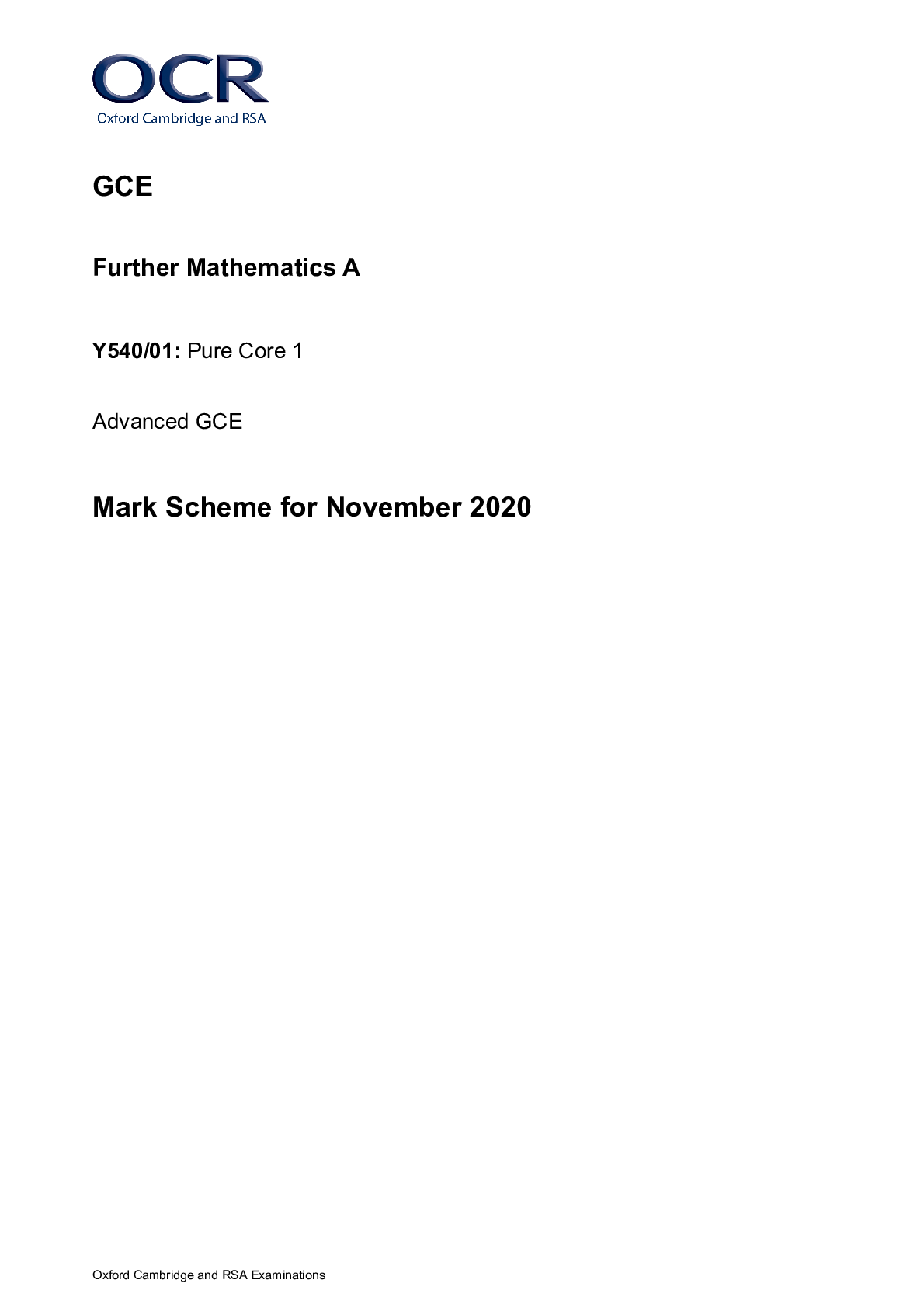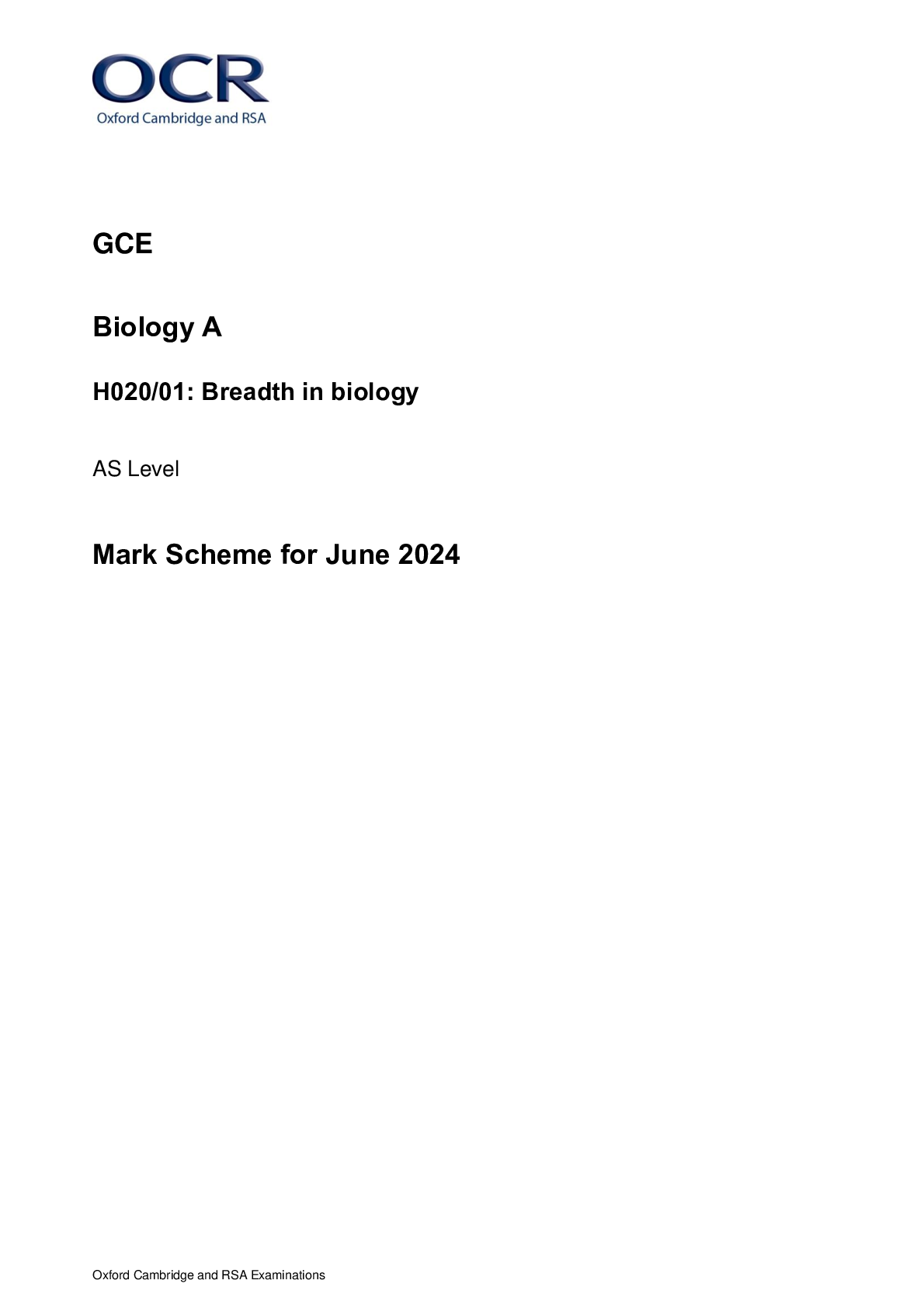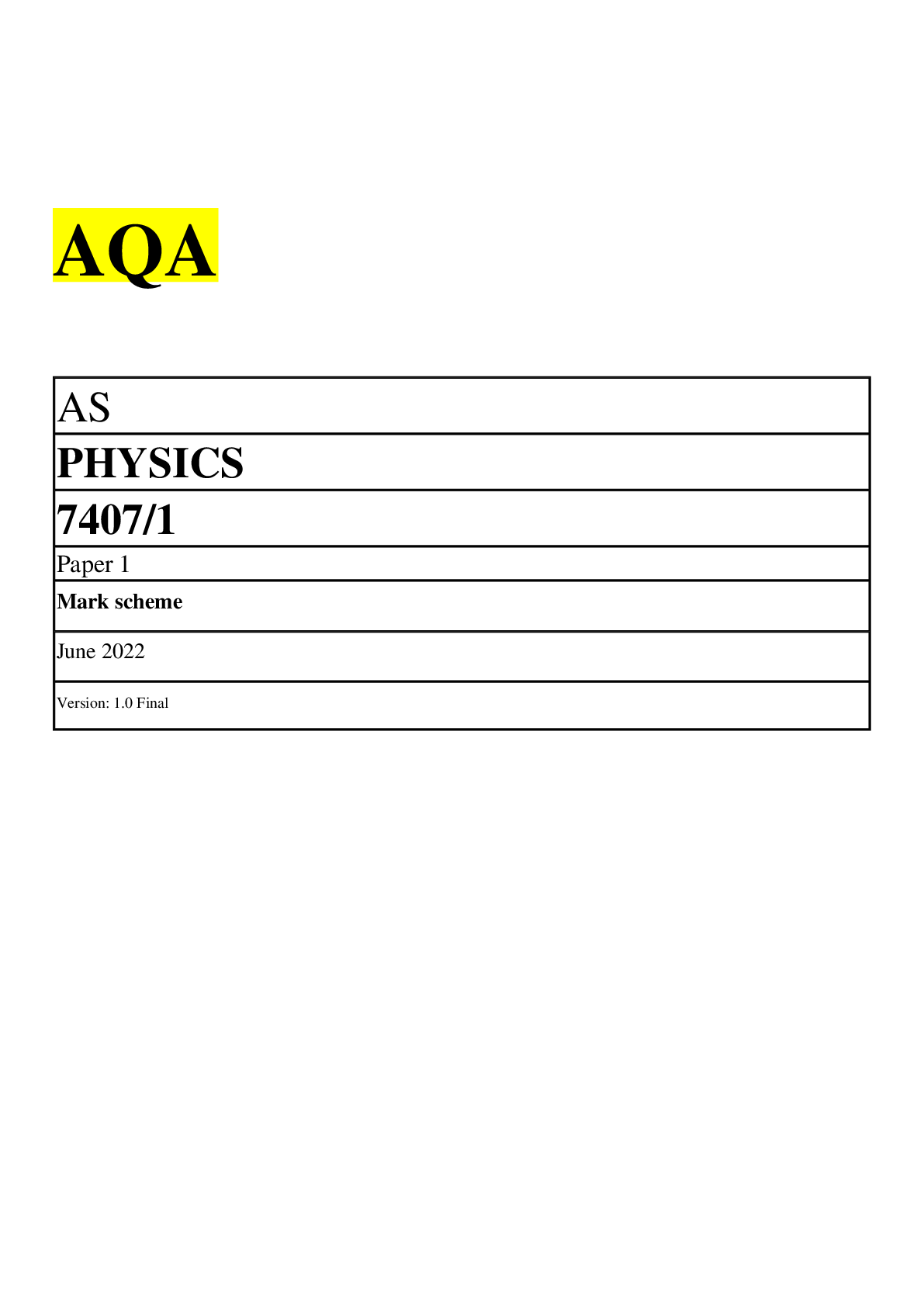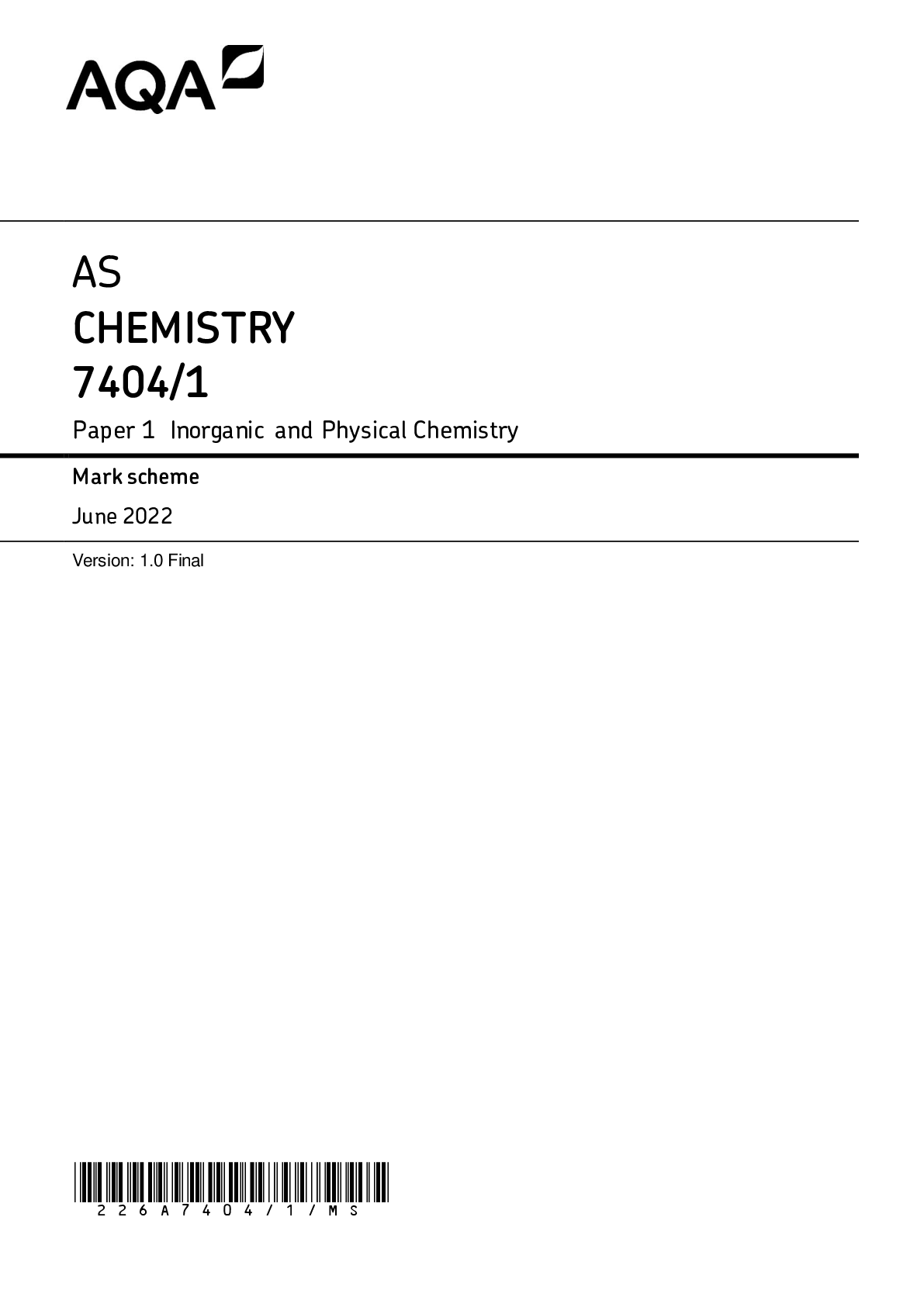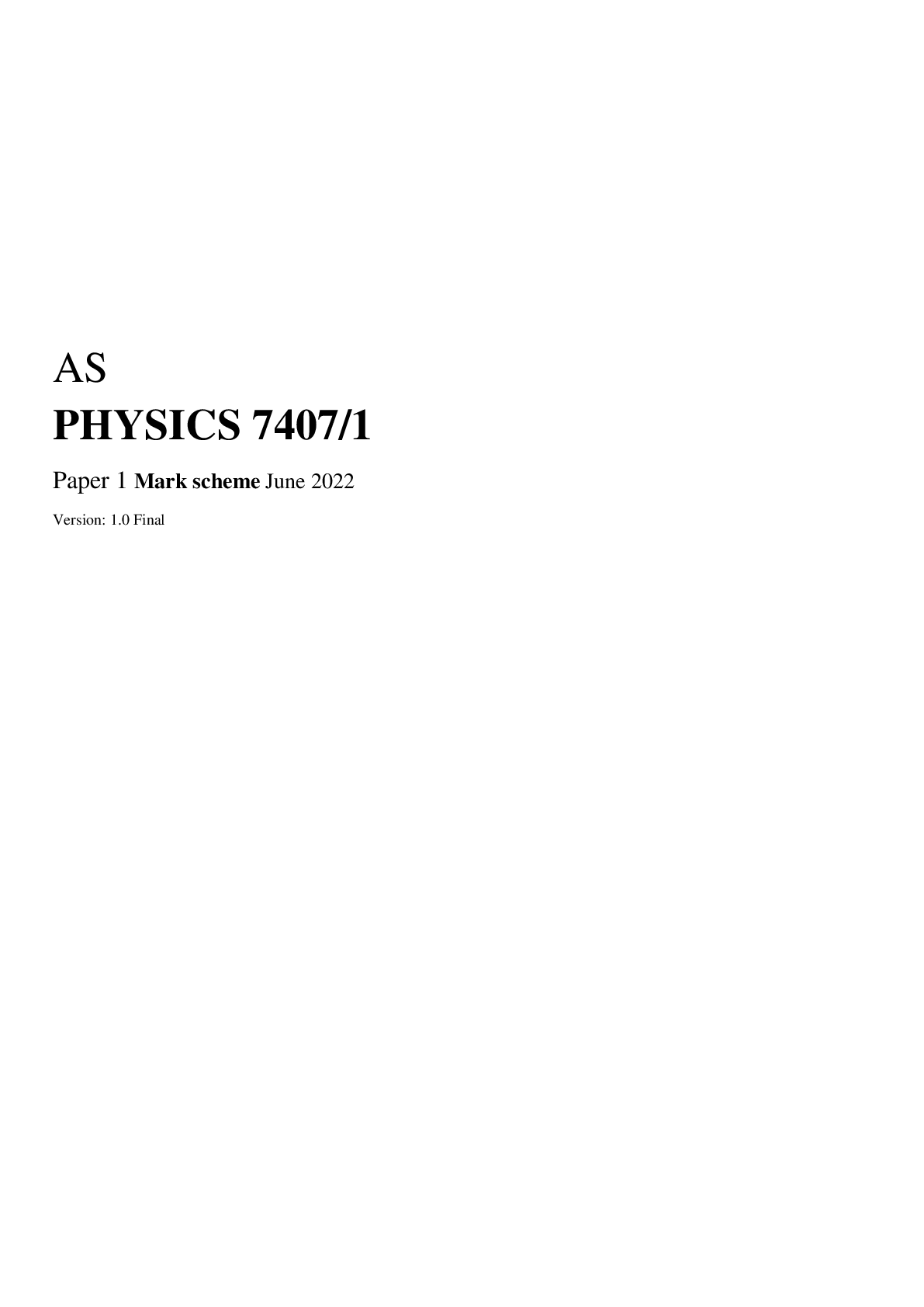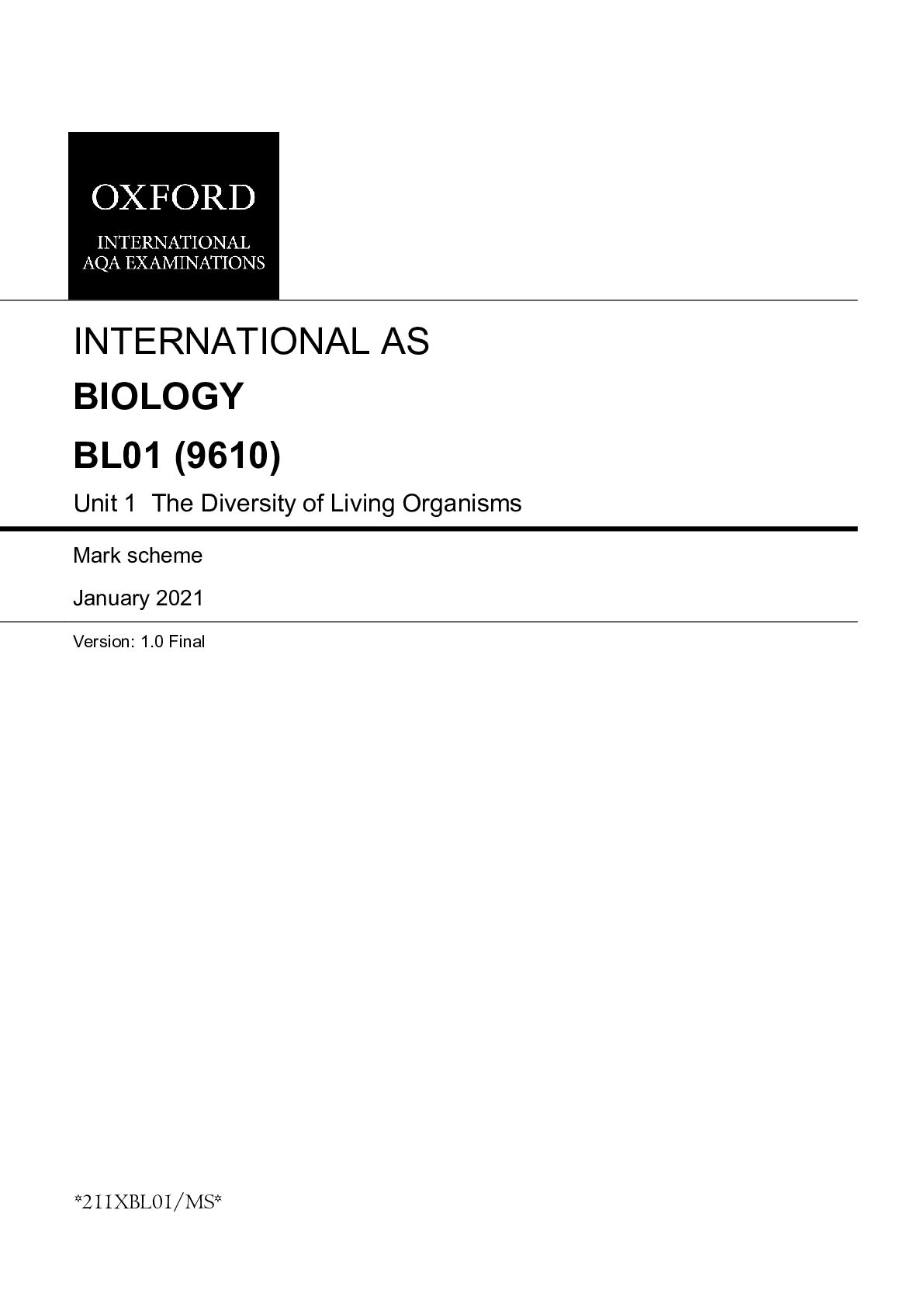Design and Technology > AS Mark Scheme > GCE Design and Technology H406/02: Problem solving in Product Design Advanced GCE Mark Scheme for No (All)
GCE Design and Technology H406/02: Problem solving in Product Design Advanced GCE Mark Scheme for November 2020
Document Content and Description Below
Oxford Cambridge and RSA Examinations GCE Design and Technology H406/02: Problem solving in Product Design Advanced GCE Mark Scheme for November 2020Oxford Cambridge and RSA Examinations OCR (Ox ... ford Cambridge and RSA) is a leading UK awarding body, providing a wide range of qualifications to meet the needs of candidates of all ages and abilities. OCR qualifications include AS/A Levels, Diplomas, GCSEs, Cambridge Nationals, Cambridge Technicals, Functional Skills, Key Skills, Entry Level qualifications, NVQs and vocational qualifications in areas such as IT, business, languages, teaching/training, administration and secretarial skills. It is also responsible for developing new specifications to meet national requirements and the needs of students and teachers. OCR is a not-for-profit organisation; any surplus made is invested back into the establishment to help towards the development of qualifications and support, which keep pace with the changing needs of today’s society. This mark scheme is published as an aid to teachers and students, to indicate the requirements of the examination. It shows the basis on which marks were awarded by examiners. It does not indicate the details of the discussions which took place at an examiners’ meeting before marking commenced. All examiners are instructed that alternative correct answers and unexpected approaches in candidates’ scripts must be given marks that fairly reflect the relevant knowledge and skills demonstrated. Mark schemes should be read in conjunction with the published question papers and the report on the examination. © OCR 2020H406/02 Mark Scheme November 2020 2 Annotations Annotation Meaning Blank Page – this annotation must be used on all blank pages within an answer booklet (structured or unstructured) and on each page of an additional object where there is no candidate response. Tick Cross Confused (replaces the question mark) Benefit of doubt AO1 – Knowledge and understanding AO2 – Apply knowledge and understanding AO3 - Analyse AO4 - Evaluation Omission Not answered question Noted but no credit given Too vague Own figure rule RepetitionH406/02 Mark Scheme November 2020 3 Question Answer Mark Guidance 1 Indicative content: Existing businesses: • Negative responses to council from local catering businesses such as cafes and pubs; interruptions to business, car parking, use of toilets by non-paying customers • Insufficient provision for waste management to include suitable provision of bins, recycling opportunities. • Security of town – for all stakeholders involved, safe movement around town, car parking, vehicular access. Police presence required. • Negative impact on the residents and neighbourhood – damage to the Town Square, dumping of waste food and rubbish at the end by traders, littering by customers and visitors. • Toilet access for all stakeholders – provision of portacabins needed, to avoid customers overloading the conveniences of local pubs and cafes. • Provision of electrical power to the site. Vendors will have numerous power hungry devices for cooking and heating food. Is there suitable rated supply available and what distribution does it need to stalls e.g. extension leads, 13a sockets. Is a generator required? Do the council expect vendors to provide their own source of power e.g. generators, bringing associated noise and pollution. • Alternative car parking for residents, vendors vehicles (cars and vans), and additional car parking for visitors. Operate a park and ride system? • Places/areas to eat and drink the produce bought. • Any other valid suggestion. In addition, for town residents: • Minimal disruption. • Access and car parking before, during and after the Street Food Fayre. • Concerns over security of property / theft when the town is busy. • Concerns related to littering, rubbish, food waste. • Concerns over spoiling aesthetic appeal of area and memorial • Disabled bays. • Any other valid suggestion. 8 If a candidate demonstrates generic knowledge about stakeholders without utilising the contextual information given in the Resource Booklet, candidates should be awarded 0 marks. Candidates may extract information from the Resource Booklet. Any such lifted information can be used in support of the critical evaluation, but no marks should be awarded simply for duplicating text. Credit should be given for responses which identify issues evident in the Level 4 [7-8 marks] A comprehensive critical examination of challenges in relation to identified stakeholder groups. Comprehensive understanding of a wide range (at least 3) of different challenges that would have been taken into account when organising the street market. Analysis of challenges is consistently and appropriately aligned with needs of target groups. Information in RB is used effectively to fully exemplify the points being made. Well-constructed narrative in relation to question with clear and supported evaluative comments. Level 3 [5-6 marks] A good critical examination of challenges in relation to stakeholder groups. Good understanding of a range (at least 2) of different challenges that would have been taken into account when organising the street market. Analysis of challenges is appropriately aligned with needs of target groups but one or two opportunities are missed to make connections. Information in RB is used for the most part effectively to exemplify points being made although one or two opportunities are missed. Well-constructed narrative in relation to question although one or two opportunities missed to develop response. Evaluative comments are clear but not always supported.H406/02 Mark Scheme November 2020 4 supplied information and which are then critically analysed and evaluated in terms of their significance to the given scenario and relating to design and technical principles. Level 2 [3-4 marks] A sufficient critical examination of challenges in relation to stakeholder groups. Sufficient understanding of challenges (at least 1) that would have been taken into account when organising the street market. Analysis of challenges is reasonably aligned with needs of target groups but there are significant opportunities missed to make connections. Informative in RB is used to exemplify some points being made although much more could have been done to exploit the stimulus material available. Reasonable narrative in relation to the question although response at times lacks depth and cohesion. Evaluative comments lack clarity and are unsupported. Level 1 [1-2 marks] A limited examination of challenges in relation to stakeholder groups. Limited knowledge and next to no understanding of challenges that would have been taken into account when organising the street market. No analysis of challenges resulting in only weak alignment with needs of target group. Use of information from the RB is used in a simplistic way and adds limited value to the points being made. Limited narrative in relation to question. Response is basic and unstructured with no evaluative comments. 0 marksH406/02 Mark Scheme November 2020 5 No response or response not worthy of credit. 2* Indicative content: • Canopy: resistance to wear and tear – 350gsm versus 450 gsm. • Appearance/ aesthetics – the aluminium hexagonal frame is better to look at than the powder coated square section frame. The hexagonal frame looks more modern. • Material and structural integrity – hexagonal sections flex less (stiffer), than square section of the same material and material thickness. • Cost – £170 vs £270 value for money, quality of finish, perceived durability/reliability. • Maintenance – ease of dismantling and cleaning. Wipe clean materials, resistant to anti-bacterial agents. • Maintenance – should a hexagonal section become damaged, a specialist component will be required from the manufacturer, or a likely delay in ordering this from a specialist metals wholesaler, whereas square section tubes are common, and readily available off the shelf at most metals suppliers. • Transportation – difference in frame weight • Ergonomics – hexagonal section tubes are more comfortable to handle as they are closer to being circular. • Resistance to knocks and rough handling – mild steel is tougher than aluminium. The hexagonal section will help to compensate for material weakness as stress is dissipated across multiple corners unlike square section where the stress is mainly on the adjacent corners to the side (face of tube) subjected to impact. • Resistance to scratching – although powder coated surfaces have a degree of resistance to scratches, if the surface of the powder coating is compromised, the mild steel beneath is likely to corrode. The tubes are then likely to start to look untidy. • Discussion could draw out that aluminium can be anodised to produce a thick oxide layer to protect the tube from the elements. Should this be scratched, a new oxide layer will form, and aesthetics will not be compromised. • Reference to the fluted surface of the aluminium to deflect and minimise damage. 12 All responses should be in relation to the existing product information provided in Fig. 4 and list of council requirements in Fig 3. For Level 4 to be awarded the majority of council requirements must be considered within the subsequent product analysis. Candidates may extract information from the Resource Booklet. Any such lifted information can be used in support of the critical evaluation but no marks should be awarded simply for duplicating text. Level 4 [10-12 marks] A comprehensive examination of the listed products against the list of council requirements. Comprehensive understanding of the functional suitability of the existing products within given context. Product analysis is consistently and appropriately aligned with list of council requirements. Information in RB is used effectively to fully exemplify the points being made. Well-constructed response in relation to question with a clear and developed narrative. There is a well-developed line of reasoning which is clear and logically structured. The information presented is relevant and substantiated. Level 3 [7-9 marks] A good critical examination of the listed products against the list of council requirements. Good level of understanding of the functional suitability of the existing products within given context. Product analysis is appropriately aligned with list of council requirements, but one or two opportunities are missed to make connections. Information in RB is used for the most part effectively to exemplify points being made although one or two opportunities are missed.H406/02 Mark Scheme November 2020 6 • Durability – resistance to rain, food, and chemical reaction to cleaning products, water-based liquids. Powder coating is only on the outside of tubes, meaning that the insides of the mild steel tubes will corrode if rain enters them, or damp air. These frames will need to be stored in warm, dry conditions. Rust from outer tubes may stain and pit the powdercoated surfaces of the inner tubes. • Foot plates – the plastic foot on the steel product is unlikely to withstand use as well as the aluminium foot plate, and it may fracture along the base of the tube if subjected to a turning force across the foot. The aluminium foot is in turn, likely to be attached to an insert that pushes into the tube, possible a polymer, and it too may fracture away from the insert when subjected to a turning force. The aluminium footplate should be harder wearing than the polymer foot plate. • Telescopic tubes: When aluminium is scratched or punched the resulting burrs may foul on the adjacent tube which causes binding of the tubes. Mild steel, being more resistant to indentation of this nature is less likely to suffer from this issue. • Any other valid suggestion. Well-constructed response in relation to question although one or two opportunities missed to develop narrative. There is a line of reasoning presented with some structure. The information presented is in the most part relevant and supported by some evidence. Level 2 [4-6 marks] A sufficient critical examination of the listed products against the list of council requirements. Sufficient understanding of the functional suitability of the existing products within given context. Product analysis is reasonably aligned with list of council requirements but there are significant opportunities missed to make connections. Informative in RB is used to exemplify some points being made although much more could have been done to exploit the stimulus material available. Reasonable response in relation to the question although narrative at times lacks depth and cohesion. The information has some relevance and is presented with limited structure. The information is supported by limited evidence. Level 1 [1-3 marks] A limited examination of the listed products against the list of council requirements. Limited knowledge and next to no understanding of the functionality suitability of the existing products within given context.H406/02 Mark Scheme November 2020 7 Isolated statements made in relation to existing products resulting in only weak alignment with list of council requirements. Use of information from the RB is used in a simplistic way and adds limited value to the points being made. Limited response in relation to question. Narrative is basic and unstructured. The information is basic and communicated in an unstructured way. The information is supported by limited evidence and the relationship to the evidence may not be clear. 0 marks No response or response not worthy of credit.H406/02 Mark Scheme November 2020 8 3 Indicative content: Removal/modification of the original foot: • Place table upside down on a clean / protective surface. • Remove table legs from the trestle table if possible. • Pozi-drive screwdrivers are likely to be required to remove self-tapping screws. • Heat ferrule with a hot air gun / hair dryer to soften the PVC and loosen any adhesive. • Remove foot by hand wearing protective glove (heat insulation) • Clean any adhesive residue with ethanol / white spirit / acetone as necessary and cloth (fumes – well ventilated area). • Align threaded insert in the tune end. • Grip the tube well in one hand (or ask a helper), or vice with neoprene / rubber vice guards with V section. • Carefully tap the tube insert into the tube using a rubber mallet ensuring that it enters the tube parallel (wooden may shatter the insert / metal hammer may also shatter) • ERW tube may have a weld bead on the inside that could foul on the insert, skewing it, or preventing it being tapped into the tube with a neat finish. • Screw the levelling foot into the insert leaving a set distance e.g. 10mm exposed to start with. • Any other valid suggestion. Avoiding damage to the trestle table: • Remove table legs from the trestle table if possible. • Grip the tube well in one hand (or ask a helper), or vice with neoprene / rubber vice guards with V section. • Any other valid suggestion. 12 Candidates can draw on practice experience of iterative designing and product analysis to support their response to this question. The question assesses applied knowledge and technical principles to the existing design so responses that focus on redesigning the existing solution should not be rewarded. The candidate is expected to demonstrate their understanding of the process involved through a series of annotated sketches and/or notes. There may be variations Level 4 [10-12 marks] A comprehensive demonstration of the manufacturing and assembly process for the upgrade. Comprehensive understanding of the manufacturing and assembly process for how the upgrade could be complete. All features covered. Information in RB is used effectively to fully exemplify the points being made. Sketches if used will be clear and supported with relevant notes. The process will be end to end and clear in the way it is explained. Level 3 [7-9 marks] A good demonstration of the manufacturing and assembly process for the upgrade. Good understanding of the manufacturing and assembly process for how the upgrade will be completed. All features covered but some features underdeveloped. Information in RB is used for the most part effectively to exemplify points being made although one or two opportunities are missed. Sketches if used will for the most part be clear and supported with relevant notes although one or two opportunities for clarity may be missed. The process will be end to end and for the most part be clear in the way it is explained.H406/02 Mark Scheme November 2020 9 to the process as indicated but to get into L3 candidates must demonstrate a clear understanding of the end to end process. Level 2 [4-6 marks] A sufficient demonstration of the manufacturing and assembly process for the upgrade. Sufficient understanding of the manufacturing and assembly process for how the upgrade will be completed. All features may not be covered and the features that are covered may be underdeveloped. Informative in RB is used to exemplify some points being made although much more could have been done to exploit the stimulus material available. Sketches if used will be adequate and supported with notes, some of which may be relevant. The process may not necessarily be end to end with some knowledge gaps evident. Level 1 [1-3 marks] A limited demonstration of the manufacturing and assembly process for the upgrade. Limited knowledge and next to no understanding of the manufacturing and assembly process for how the upgrade will be completed. Use of information from the RB is used in a simplistic way and adds limited value to the points being made. Sketches if used will be unclear with only basic notes to accompany them. The end to end process may not exist and if anything is basic in nature. 0 marks No response or no response worth of credit.H406/02 Mark Scheme November 2020 10H406/02 Mark Scheme November 2020 11 4* Indicative content: The Council: • The Bambeat products, whilst predominantly made from sustainable materials, are also made from melamine which is a thermo-setting polymer and not recyclable. • Disposal of broken or damaged Bambeat products is difficult to achieve in an environmentally conscious way. • Non-disposable items are likely to take up more space than disposable. Is additional space needed in the vehicle that transports • Initial start-up costs could be prohibitive. Cost of crockery and cutlery in addition to the return bin/station. • How are damages managed? Are customers charged replacement price? • Deposits are unlikely to cover the cost of replacement. Some customers may want to keep their items and forfeit the deposits. The items may be desirable for camping, picnic use. • Better suited to enclosed street food markets where customers can pay a deposit, say £5, at the entrance and have it returned when they leave. • Additional time and labour required to oversee the returns. • Where will stations be located. The town square has many roads accessing it. It may be necessary to have clean Bambeat station, dirty Bambeat station, and payment point, at every road access. This is possibly going to require two employees/volunteers at every access point i.e. 10 people. • Any other valid suggestion. Customers: • May be turned off by higher prices that include the cost of the crockery and cutlery deposits. • Like to buy food and walk eating it. It may not be convenient to return the crockery to the original station for cleaning. • In a street food market the bins will need to be obvious and abundant. • Need access to bins near sitting areas. • May not want to get their hands dirty scraping plates. • May want clean plates for different dishes. Is there an exchange station? • Disabled users may have specific issues with product 12 If a candidate demonstrates generic knowledge about stakeholders without utilising the contextual information given in the Resource Booklet, candidates should be awarded 0 marks. Candidates may extract information from the Resource Booklet. Any such lifted information can be used in support of the critical evaluation but no marks should be awarded simply for duplicating text. Credit should be given for responses which identify issues evident in the supplied information and which are then Level 4 [10-12 marks] A comprehensive critical examination of challenges in relation to identified stakeholder groups. Comprehensive understanding of a wide range (at least 3) of different challenges that would be faced in providing and using the stated product. Analysis of challenges is consistently and appropriately aligned with needs of target groups. Information in RB is used effectively to fully exemplify the points being made. Well-constructed narrative in relation to question with clear and supported evaluative comments. There is a well-developed line of reasoning which is clear and logically structured. The information presented is relevant and substantiated. Level 3 [7-9 marks] A good critical examination of challenges in relation to identified stakeholder groups. Good understanding of a range (at least 2) of different challenges that would be faced in providing and using the stated product. Analysis of challenges is appropriately aligned with needs of target groups but one or two opportunities are missed to make connections. Information in RB is used for the most part effectively to exemplify points being made although one or two opportunities are missed. Well-constructed narrative in relation to question although one or two opportunities missed to develop response. EvaluativeH406/02 Mark Scheme November 2020 12 • Difficult to hold a plate and cup. Would it better to rent the products separately? Or, plates and cutlery together. Cups separate. • There is a shortage of areas to sit and eat with plated food and cup. • Any other valid suggestion critically analysed and evaluated in terms of their significance to the given scenario and relating to design and technical principles. comments are clear but not always supported. Well-constructed response in relation to question although one or two opportunities missed to develop narrative. There is a line of reasoning presented with some structure. The information presented is in the most part relevant and supported by some evidence. Level 2 [4-6 marks] A sufficient critical examination of challenges in relation to identified stakeholder groups. Sufficient understanding of challenges (at least 1) that would be faced in providing and using the stated product. Analysis of challenges is reasonably aligned with needs of target groups but there are significant opportunities missed to make connections. Informative in RB is used to exemplify some points being made although much more could have been done to exploit the stimulus material available. Reasonable narrative in relation to the question although response at times lacks depth and cohesion. Evaluative comments lack clarity and are unsupported. The information has some relevance and is presented with limited structure. The information is supported by limited evidence. Level 1 [1-3 marks] A limited examination of challenges in relation to identified stakeholder groups.H406/02 Mark Scheme November 2020 13 Limited knowledge and next to no understanding of challenges that would be faced when in providing and using the stated product. No analysis of challenges resulting in only weak alignment with needs of target group. Use of information from the RB is used in a simplistic way and adds limited value to the points being made. Limited narrative in relation to question. Response is basic and unstructured with no evaluative comments. The information is basic and communicated in an unstructured way. The information is supported by limited evidence and the relationship to the evidence may not be clear. 0 marks No response or response not worthy of credit.H406/02 Mark Scheme November 2020 14 5 Indicative content: Responses may consider an initial batch of units. Manufacturing methods should then be suited to batch manufacture. Jigs / batch manufacture considerations Frame: • Base up assembly. • Mild steel / aluminium / Stainless steel box sections. • Possible reinforcing webs to attach castor plates. • MIG welded (steel) or TIG welded (aluminium/stainless steel) • Base and frame made from 19mm square section mild steel/aluminium/stainless steel tubing • Handle Side rails, 19mm x 40mm box section welded onto the main side- square frame. • Handle 25mm diameter aluminium extruded tube 2mm wall thickness / mild steel ERW 1.6mm wall thickness. Neoprene sleeve added. • Aluminium/Stainless steel is an expensive option, mild steel is the cheaper alternative, but would need to be powder coated. • Mild steel is denser than stainless steel / aluminium. • Finishes – linked to materials • Any other valid suggestion. Wheels: • Castors: 2 following 2 swivelling to allow the trolley to move in curves and be easily manoeuvred. • 2 swivelling wheels to the front for ease of steering. • 100mm base clearance to include the sub-frame for mounting the castors. 50mm castors could suit this product. • Rear castors could be braked to prevent the trolley moving when in use. • Likely to use plated versions to attach to a modified base frame. • Flat pack / assembly: • Connecting box section base/frames (standardised components) 20 Candidates can draw on practice experience of iterative designing and product analysis to support their response to this question. The question assesses applied knowledge and technical principles to the existing design so responses that focus on redesigning the existing solution should not be rewarded. The candidate is expected to demonstrate their understanding of the process involved through a series of annotated sketches and/or notes. There may be variations to the process as indicated but to get into L3 Level 4 [15-20 marks] A comprehensive demonstration of an assembly method within the context provided. Comprehensive understanding of an assembly process that would be used in order for the trolley to be flatpacked. All features covered. Information in RB is used effectively to fully exemplify the points being made. Sketches if used will be clear and supported with relevant notes. The process will be end to end and clear in the way it is explained. Level 3 [9-14 marks] A good demonstration of an assembly method within the context provided. Good understanding of an assembly process that would be used in order for the trolley to be flatpacked. All features covered but some features underdeveloped. Information in RB is used for the most part effectively to exemplify points being made although one or two opportunities are missed. Sketches if used will for the most part be clear and supported with relevant notes although one or two opportunities for clarity may be missed. The process will be end to end and for the most part be clear in the way it is explained. Level 2 [5-8 marks] A sufficient demonstration of an assembly method within the context provided. Sufficient understanding of an assembly process that would be used for the trolley to be flatpacked. All features may not beH406/02 Mark Scheme November 2020 15 candidates must demonstrate a clear understanding of the end to end process. covered and the features that are covered may be underdeveloped. Informative in RB is used to exemplify some points being made although much more could have been done to exploit the stimulus material available. Sketches if used will be adequate and supported with notes, some of which may be relevant. The process may not necessarily be end to end with some knowledge gaps evident. Level 1 [1-4 marks] A limited demonstration of an assembly method within the context provided. Limited knowledge and next to no understanding of an assembly process that would be used for the trolley to be flatpacked. Use of information from the RB is used in a simplistic way and adds limited value to the points being made. Sketches if used will be unclear with only basic notes to accompany them. The end to end process may not exist and if anything is basic in nature. 0 marks No response or no response worth of credit.H406/02 Mark Scheme November 2020 16 6 Removing a plate and cup from the overall height: 581 – 25 = 556 mm left (plates) 581 – 132 = 449 mm left (cups) (1) Plates Division by 5 556*/5 (1) = 111.2 Maximum number of plates: 111.2* rounded down to 111 + 1 (original plate) = 112 (1) Cups Division by 10: 449*/10 (1) = 44.9 Maximum number of cups: 44.9* rounded down to 44 + 1 (original cup) = 45 (1) Number of cups: 45* x 2 = 90 (1) 6 Award six marks as follows: One mark for removing a plate and cup height from the overall height. One mark for working out the division by 5 for plates. One mark for working out the division by 10 for cups. One mark for calculating the maximum number of plates. One mark for calculating the number of cups needed. One mark for calculating the total number of cups needed given there are two slots for cups on the trolley. If correct answer is given without working out shown award full marks. Where an incorrect answer is given working out should be used to credit appropriate marks. *Allow error carried forward (ECF) where correct working out is shown.OCR (Oxford Cambridge and RSA Examinations) The Triangle Building Shaftesbury Road Cambridge CB2 8EA [Show More]
Last updated: 3 years ago
Preview 1 out of 18 pages
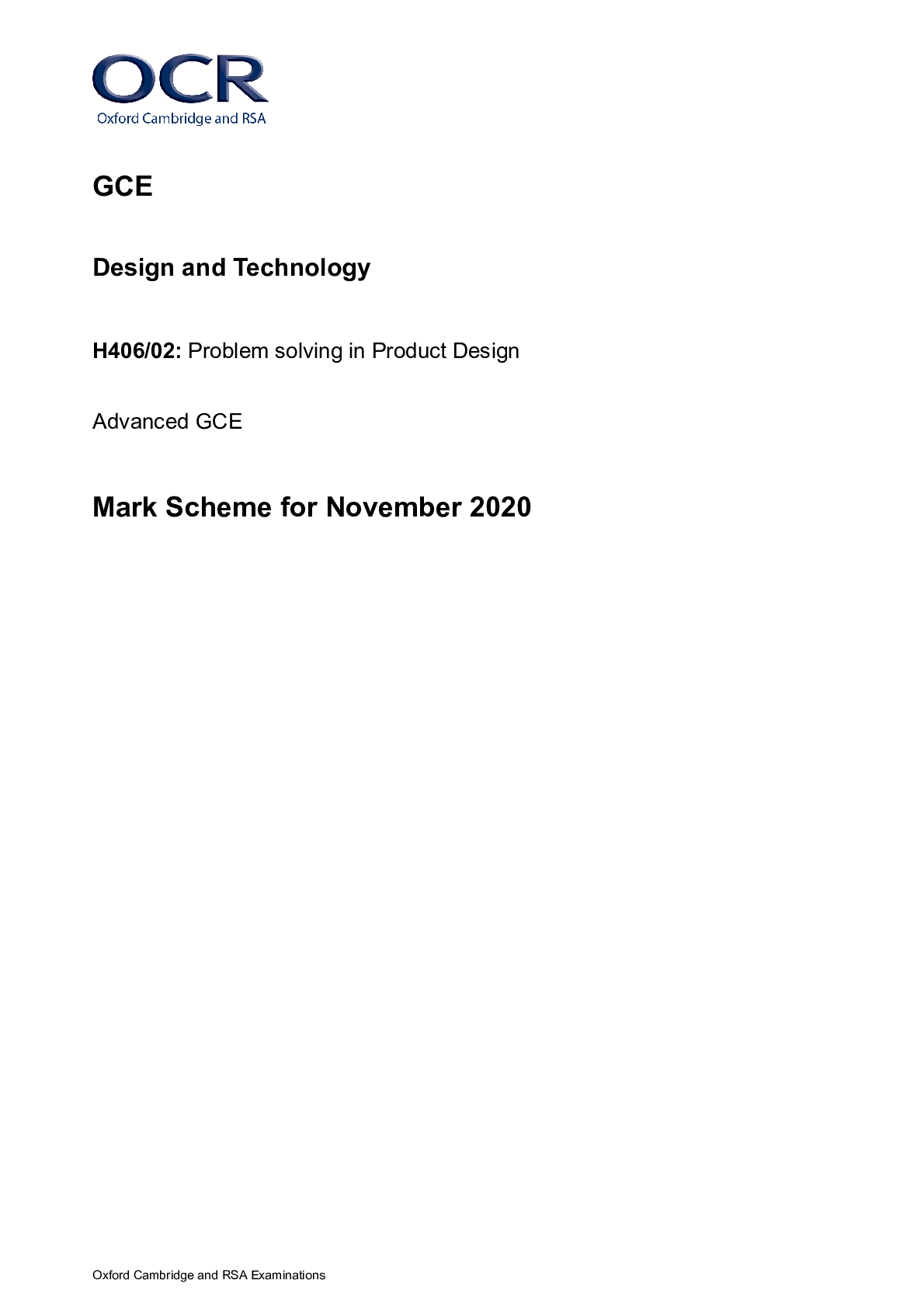
Buy this document to get the full access instantly
Instant Download Access after purchase
Buy NowInstant download
We Accept:

Reviews( 0 )
$7.50
Can't find what you want? Try our AI powered Search
Document information
Connected school, study & course
About the document
Uploaded On
Oct 10, 2022
Number of pages
18
Written in
All
Additional information
This document has been written for:
Uploaded
Oct 10, 2022
Downloads
0
Views
125











